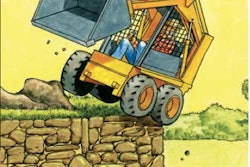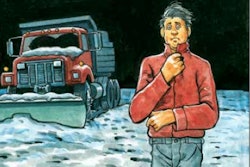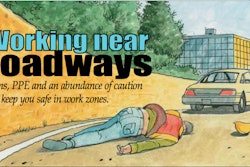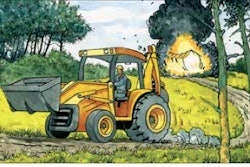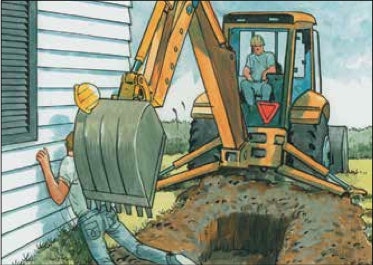
What the expert says: Both workers made common mistakes that led to this accident. The operator should have lowered the boom to a safe position with the bucket on the ground and turned off the machine before stepping off for any reason.
The man in the trench should have been aware of the backhoe’s swing zone and stayed out of it. Marking swing areas with rope, tape or other barriers is a good idea. “Staying in the machine is critical to safely operating the backhoe,” says Jim Blower, product manager for JCB’s backhoe loader line. Operators who contacted levers – inadvertently or intentionally – while out of the seat have been injured or killed themselves when they were crushed between the swinging boom and the machine. The No. 1 safety-related mistake backhoe operators performing landscaping applications make is overestimating the machine’s capabilities, Blower says.
Backhoe loaders used in these applications are typically small – in the 10-foot or 12-foot dig depth categories – but operators often think they can perform the tasks of a full-size machine. If you overwork the machine or lift pallets of block or other materials that are too heavy, accidents can happen. The loader’s spec sheet and operator’s manual will tell you its limitations. Ask your employer or supervisor to show you one of these. If you’ll be using forks to lift pallets, you or the person delivering the material to the jobsite should ask the supplier how much each weighs.
Be aware of your surroundings and ground conditions at all times. When operating on soft ground, slow your speed accordingly. If you’re traveling over a slope, the heaviest part of the machine should face up the slope. When there’s a heavy load in the bucket, this will be the front of the machine; when unloaded, it’s the rear.
Remain seated with the seat belt fastened the entire time you’re operating a backhoe loader. Often, when a machine begins to tip, the operator will try to jump from it, Blower says. This is the worst thing you could do. “Stay in the cab,” Blower says. “It’s the safest place to be. The cab is designed to take that impact.”
Never operate a backhoe loader until a person familiar with that particular machine has trained you. “These are quite powerful machines,” Blower says. “You need to know what every button and lever does before you start operating it.”

